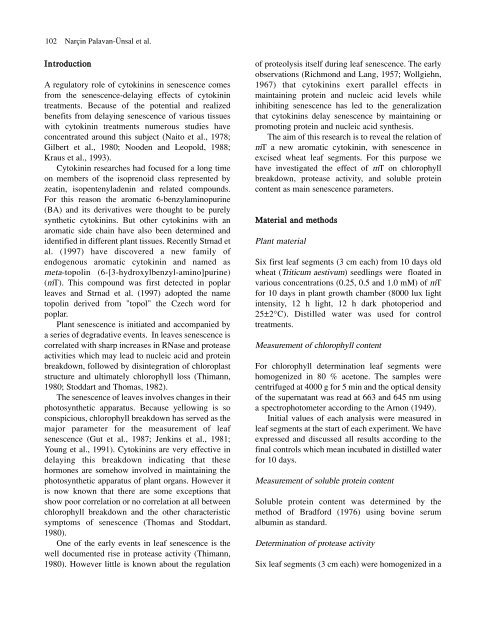Full Journal - Journal of Cell and Molecular Biology - Haliç Üniversitesi
Full Journal - Journal of Cell and Molecular Biology - Haliç Üniversitesi
Full Journal - Journal of Cell and Molecular Biology - Haliç Üniversitesi
You also want an ePaper? Increase the reach of your titles
YUMPU automatically turns print PDFs into web optimized ePapers that Google loves.
102 Narçin Palavan-Ünsal et al.<br />
Introduction<br />
A regulatory role <strong>of</strong> cytokinins in senescence comes<br />
from the senescence-delaying effects <strong>of</strong> cytokinin<br />
treatments. Because <strong>of</strong> the potential <strong>and</strong> realized<br />
benefits from delaying senescence <strong>of</strong> various tissues<br />
with cytokinin treatments numerous studies have<br />
concentrated around this subject (Naito et al., 1978;<br />
Gilbert et al., 1980; Nooden <strong>and</strong> Leopold, 1988;<br />
Kraus et al., 1993).<br />
Cytokinin researches had focused for a long time<br />
on members <strong>of</strong> the isoprenoid class represented by<br />
zeatin, isopentenyladenin <strong>and</strong> related compounds.<br />
For this reason the aromatic 6-benzylaminopurine<br />
(BA) <strong>and</strong> its derivatives were thought to be purely<br />
synthetic cytokinins. But other cytokinins with an<br />
aromatic side chain have also been determined <strong>and</strong><br />
identified in different plant tissues. Recently Strnad et<br />
al. (1997) have discovered a new family <strong>of</strong><br />
endogenous aromatic cytokinin <strong>and</strong> named as<br />
meta-topolin (6-[3-hydroxylbenzyl-amino]purine)<br />
(mT). This compound was first detected in poplar<br />
leaves <strong>and</strong> Strnad et al. (1997) adopted the name<br />
topolin derived from "topol" the Czech word for<br />
poplar.<br />
Plant senescence is initiated <strong>and</strong> accompanied by<br />
a series <strong>of</strong> degradative events. In leaves senescence is<br />
correlated with sharp increases in RNase <strong>and</strong> protease<br />
activities which may lead to nucleic acid <strong>and</strong> protein<br />
breakdown, followed by disintegration <strong>of</strong> chloroplast<br />
structure <strong>and</strong> ultimately chlorophyll loss (Thimann,<br />
1980; Stoddart <strong>and</strong> Thomas, 1982).<br />
The senescence <strong>of</strong> leaves involves changes in their<br />
photosynthetic apparatus. Because yellowing is so<br />
conspicious, chlorophyll breakdown has served as the<br />
major parameter for the measurement <strong>of</strong> leaf<br />
senescence (Gut et al., 1987; Jenkins et al., 1981;<br />
Young et al., 1991). Cytokinins are very effective in<br />
delaying this breakdown indicating that these<br />
hormones are somehow involved in maintaining the<br />
photosynthetic apparatus <strong>of</strong> plant organs. However it<br />
is now known that there are some exceptions that<br />
show poor correlation or no correlation at all between<br />
chlorophyll breakdown <strong>and</strong> the other characteristic<br />
symptoms <strong>of</strong> senescence (Thomas <strong>and</strong> Stoddart,<br />
1980).<br />
One <strong>of</strong> the early events in leaf senescence is the<br />
well documented rise in protease activity (Thimann,<br />
1980). However little is known about the regulation<br />
<strong>of</strong> proteolysis itself during leaf senescence. The early<br />
observations (Richmond <strong>and</strong> Lang, 1957; Wollgiehn,<br />
1967) that cytokinins exert parallel effects in<br />
maintaining protein <strong>and</strong> nucleic acid levels while<br />
inhibiting senescence has led to the generalization<br />
that cytokinins delay senescence by maintaining or<br />
promoting protein <strong>and</strong> nucleic acid synthesis.<br />
The aim <strong>of</strong> this research is to reveal the relation <strong>of</strong><br />
mT a new aromatic cytokinin, with senescence in<br />
excised wheat leaf segments. For this purpose we<br />
have investigated the effect <strong>of</strong> mT on chlorophyll<br />
breakdown, protease activity, <strong>and</strong> soluble protein<br />
content as main senescence parameters.<br />
Material <strong>and</strong> methods<br />
Plant material<br />
Six first leaf segments (3 cm each) from 10 days old<br />
wheat (Triticum aestivum) seedlings were floated in<br />
various concentrations (0.25, 0.5 <strong>and</strong> 1.0 mM) <strong>of</strong> mT<br />
for 10 days in plant growth chamber (8000 lux light<br />
intensity, 12 h light, 12 h dark photoperiod <strong>and</strong><br />
25±2°C). Distilled water was used for control<br />
treatments.<br />
Measurement <strong>of</strong> chlorophyll content<br />
For chlorophyll determination leaf segments were<br />
homogenized in 80 % acetone. The samples were<br />
centrifuged at 4000 g for 5 min <strong>and</strong> the optical density<br />
<strong>of</strong> the supernatant was read at 663 <strong>and</strong> 645 nm using<br />
a spectrophotometer according to the Arnon (1949).<br />
Initial values <strong>of</strong> each analysis were measured in<br />
leaf segments at the start <strong>of</strong> each experiment. We have<br />
expressed <strong>and</strong> discussed all results according to the<br />
final controls which mean incubated in distilled water<br />
for 10 days.<br />
Measurement <strong>of</strong> soluble protein content<br />
Soluble protein content was determined by the<br />
method <strong>of</strong> Bradford (1976) using bovine serum<br />
albumin as st<strong>and</strong>ard.<br />
Determination <strong>of</strong> protease activity<br />
Six leaf segments (3 cm each) were homogenized in a

















